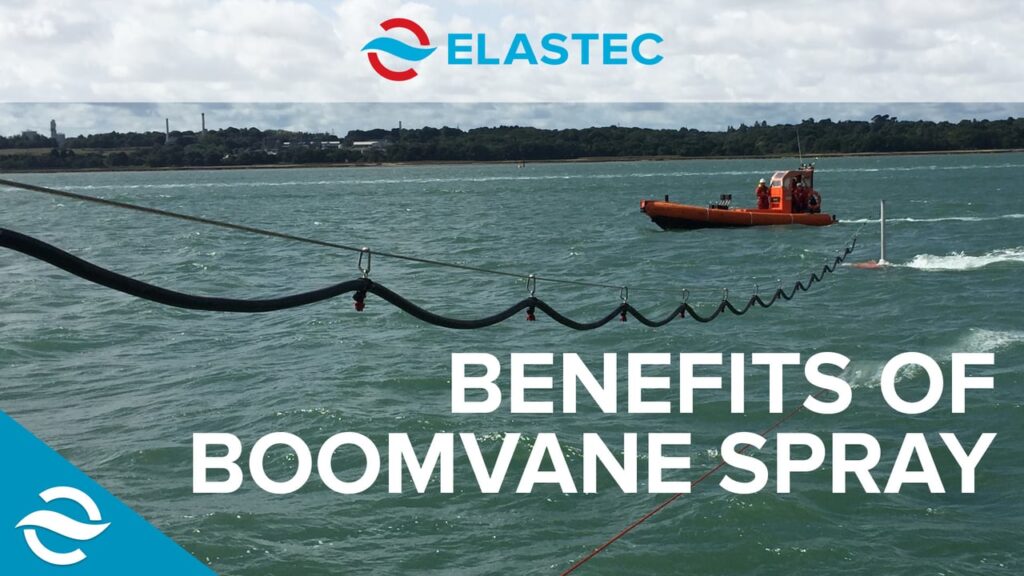BOOMVANE SPRAY
The Elastec BoomVane™ Spray system can be deployed from small service vessels, such as coastal fishing boats, pilot and work boats, for dispersant application on marine oil spills. The 1m BoomVane allows for a wider spray width (65 ft / 20 m) than conventional arm systems. Read our Frequently Asked Questions.
The BoomVane Spray has been developed with funding from NOFO (Norwegian Clean Seas Association for Operating Companies) with the objective of providing low displacement vessels a way to safely spray dispersants in deep water close to shore. Dispersant application can be performed at 4 to 5 knots and in wind speeds up to Beaufort 5.
The system comes complete with a choice of dispersant pump sets or alternatively existing units may be integrated into the setup. Our pump set will apply neat or diluted dispersant from a 82 ft / 25 m nozzle hose assembly which is suspended between the vessel and the BoomVane mast. The 13 nozzle hose assembly is stored on an aluminium reel.
As the BoomVane is towed in the water, it swings out and away from the vessel, held by a single tow line. When in operating position off the vessel side, the nozzle hose is run out along a line to the masthead. The tilt prevention rigging inside the mast keeps it vertical when the load is applied.
The BoomVane is capable of supporting the mast and dispersant spray hose and line. The BoomVane is self-balancing, no adjustments or trimming are required. Completely stable and insensitive to wave action, BoomVane may be used for towing booms when not being used in the spray system.
The standard system features an electric start diesel pump unit with back up hand start and a capacity of up to 107 liters per minute / 28 gallons per minute, delivering concentrate or diluted dispersant. The pump is self-priming and can draw dispersant from tanks below decks.
Contact us to learn more.
BOOMVANE SPRAY PHOTOS
BOOMVANE SPRAY VIDEO
Oil Dispersant Application System Frequently Asked Questions
What is an oil spill dispersant?
“Dispersants” as they are known generically are low toxicity chemicals that are used to break up oil on the surface of the water and promote natural degradation. They are a tool used alongside mechanical recovery and in-situ burning.
When are dispersants used?
Dispersant is typically used in large scale incidents offshore when other means are limited. Responders will go through a net environmental benefit analysis.
Where is it used?
Dispersant is not typically used in shallow or inland waters.
How is it applied?
Dispersant has to be sprayed in the correct manner to ensure effectiveness. It may be sprayed from aircraft or ships.
Does dispersant usage have to be approved?
Yes. The use of oil dispersants is regulated in most countries. Not only does the use need to be approved, the chemical itself has to undergo testing for toxicity and effectiveness.
Products Available for Use During an Oil Spill
Dispersant use approvals in the United States
What dispersant spray systems does Elastec offer?
We have three different systems, Elaspray is a conventional pump and arm setup, with arms that are mounted to the side of a ship. The Neatsweep is more precise as oil is funneled to a channel where the oil dispersant is applied ( dosage automatically adjusts to the speed of the vessel ), and the Boom Vane Spray (BVS). The BVS system enables vessels to get closer to shore with a wider swath than arms.
ASTM Standards for Oil Spill Dispersants
The following links offer information related to ASTM International standards for oil spill dispersants.
- F1209-19 Standard Guide for Ecological Considerations for the Use of Oil Spill Dispersants in Freshwater and Other Inland Environments, Ponds and Sloughs
- F1210-19 Standard Guide for Ecological Considerations for the Use of Oil Spill Dispersants in Freshwater and Other Inland Environments, Lakes and Large Water Bodies
- F1231-19 Standard Guide for Ecological Considerations for the Use of Oil Spill Dispersants in Freshwater and Other Inland Environments, Rivers and Creeks
- F1413/F1413M-18 Standard Guide for Oil Spill Dispersant Application Equipment: Boom and Nozzle Systems
- F1460/F1460M-18 Standard Practice for Calibrating Oil Spill Dispersant Application Equipment Boom and Nozzle Systems
- F1737/F1737M-19 Standard Guide for Use of Oil Spill Dispersant Application Equipment During Spill Response: Boom and Nozzle Systems
- F1738-19 Standard Test Method for Determination of Deposition of Aerially Applied Oil Spill Dispersants
- F1872-17 Standard Guide for Use of Chemical Shoreline Cleaning Agents: Environmental and Operational Considerations
- F2059-17 Standard Test Method for Laboratory Oil Spill Dispersant Effectiveness Using the Swirling Flask
- F2205-19 Standard Guide for Ecological Considerations for the Use of Chemical Dispersants in Oil Spill Response: Tropical Environments
- F2465/F2465M-20 Standard Guide for Oil Spill Dispersant Application Equipment: Single-point Spray Systems
- F2532-19 Standard Guide for Determining Net Environmental Benefit of Dispersant Use
- F3251-17 Standard Test Method for Laboratory Oil Spill Dispersant Effectiveness Using the Baffled Flask



















